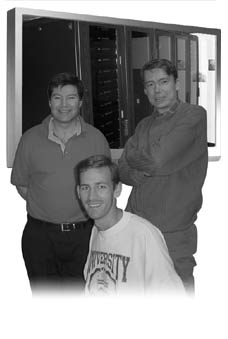

|
|
|
|
|
|
|
|
|
|
|
 |
 |
||||||||
|
|
|||||||||
|
|
|||||||||
|
|
|||||||||
 |
CoLab Seminar Thursday, Nov 27, 2003 at 3.30pm in P8493 Title
Abstract The Mathematica-based Windows knot theory program LinKnot is the extension of the program Knot2000 (K2K) written by M.Ochiai and N.Imafuji. LinKnot is the knot theory program that works with knots and links (KLs) given in the Conway notation. Conway symbols are an input used for creating Dowker codes or P-data (the main input for K2K functions). Instead of a graphical input or Dowker codes, for the first time in a computer program you can use human-comprehensive Conway notation of KLs represented as a Mathematica string and work with links, and not only with knots. For all KLs there is no restriction on the number of crossings. The program provides also the complete data base of alternating KLs with at most 12 crossings, and non-alternating KLs with at most 11 crossings, and the data base of basic polyhedra with at most 20 crossings.
By using it, it is possible to draw KLs, calculate all polynomial invariants of KLs, work with braids, reduce KLs, etc. For the first time, it is possible to compute unknotting and unlinking numbers, calculated according to Bernhard-Jablan Conjecture. For all alternating KLs you can compute minimum Dowker codes, find all non-isomorphic projections, work with the graphs of KLs, compute linking numbers, breaking and spliting numbers, signatures, and many other KL invariants.
The main property of the program is a possibility to use it as a tool in experimenting with KLs, for computing properties connected with infinite classes of KLs (KL families) and make new conjectures in knot theory. For example, except the famous Nakanishi-Bleiler exapmle of a knot 514 with the unknotting number projection gap, we discovered an infinite collection of such KLs.
Biography Slavik (Vlado) Jablan graduated in mathematics from the University of Belgrade (1971), where also gained his MA degree (1981) with the multidisciplinary thesis "Theory of Symmetry and Applied Painting", and PhD degree (1984) with the dissertation "Theory of Simple and Multiple Antisymmetry in E^2". Participated in the Advanced Scientific Program in Kishinev (Moldavia) 1985 and in USA and Canada (1990). Fulbright scholar in 1992. Published three monographs and more than 50 papers on the theory of symmetry and ornament, antisymmetry, colored symmetry, ethnomathematics and knot theory. The main fields of his interest are: the history of ornamental art (archaeology, ethnomathematics) and its analysis from the point of view of the theory of symmetry, as well as the ornamental design and the theory of visual perception. His design "Two-Colored Ornamental Tilings" got the award: an honorable mention at the International Competition of Industrial Design and New Technology CEVISAMA-'87 (Valencia, Spain).
Affiliation
Member of ULUPUDS
The Regional Chairman (1989-1995), member of the Advisory Board (1995-2001) and the Executive Secretary (2001- ) of ISIS Symmetry
The Editor of the electronic journal "Visual Mathematics".
|
 |